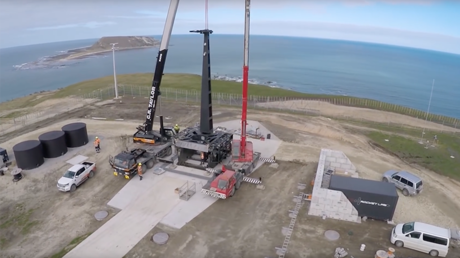‘We’ll sell launches, not promises’: Russia’s S7 joins space race with Sea Launch platform purchase
Russia’s privately-owned S7 Group plans to conquer the niche space launch market and compete with the likes of SpaceX after purchasing the Sea Launch complex, a mobile maritime platform that halted operations two years ago.
The agreement between S7 and the Sea Launch Group was signed Tuesday at the International Astronautical Congress in Guadalajara, Mexico. The assets purchased by S7 include the Sea Launch Commander vessel and the Odyssey Launch Platform, in addition to various pieces of support equipment and a port facility in Long Beach, California.
Once the ownership exchange process has been completed, the largest private aviation holding company in Russia plans to use the brain power behind the Russian space program and has signed a separate contract with Russian space corporation “ RSC Energia” to resuscitate the Sea Launch complex’s delivery capabilities.
RSC Energia, which has been conducting activities in the rocket-space industry since 1946, will offer the enterprise “all the required engineering support and assistance” for the preparation of launches and in system integration. After all, RSC Energia was involved in the creation of Sea Launch, which itself is more than two decades old.
“The deal is to be closed within six months, the timeline needed to obtain the necessary approvals of the relevant US authorities and sign a number of agreements that are part of the deal. The transaction is subject to approvals from the Directorate of Defense Trade Controls (DDTC) and the Committee on Foreign Investment in the United States (CFIUS),” S7 Group said in a press release.
After the deal is sealed S7 hopes to restart space launches in 18 months, sometime in late 2018.
“We expect to be able to perform up to 70 launches within 15 years without making any major investments in upgrades to the Sea Launch complex. Our business approach is radically different from what you see at many companies: we will not sell promises, we will sell launches only when our launch vehicles are ready to take to the atmosphere,” said Vladislav Filev, CEO of S7 Group.
#ElonMusk outlines plan to make #Mars colonization more affordable https://t.co/8yDEXjQBNCpic.twitter.com/IGPwWslnWR
— RT America (@RT_America) September 27, 2016
The CEO stressed that the holding’s partnership with Energia will not be limited to launch services and the Sea Launch project. Space-based transportation infrastructure will also be developed in tandem.
“The acquisition of the Sea Launch is a 'ticket' for us to enter the space industry. Space infrastructure is developing rapidly. In our view, it is a very exciting area of business, with good long-term prospects,” noted Filеv.
Throughout the Sea Launch company’s history, the enterprise offered some of the lowest-cost solutions for delivering cargo into space. Because it is launched from the Pacific Ocean, rockets can be fired from an optimum position on the Earth’s surface, maximizing the payload capacity while reducing launch costs compared to land-based systems.
The company quickly established a multi-step process for space deliveries. First, the launcher and its payload are assembled on a purpose-built ship, Sea Launch Commander, in Long Beach, California. Then the rocket and the cargo are positioned on top of the self-propelled platform, Ocean Odyssey, and towed to the equatorial Pacific Ocean for launch. The Sea Launch Commander serves as the command center. All Sea Launch missions have used the custom-designed three-stage Zenit-3SL launch vehicle, capable of placing up to 6,000 kg (13,000 lb) of payload into geosynchronous transfer orbit.
Announcing the deal S7 CEO confirmed that Zenit rocket will remain the driving force for the next 15-20 launches in a $160 million project. Filev also expressed his strong belief in the profitability of the business venture.
“There is a multi-year waiting list for launches, so we believe that our service will be in demand,” Filev told Bloomberg.
With the reemergence of the Sea Launch complex as a strong market player, the company has set itself up as a candidate which could potentially capture a portion of the market now controlled by Elon Musk’s Space Exploration Technologies Corp and SpaceX Falcon 9 launches, which completed its first landing on a sea platform earlier this year.
Tariq Malik, managing editor of space.com, believes that S7 can now offer “another option” to satellite operators for sending equipment into orbit.
“Sea Launch is a very unique launch platform in that they have this floating asset where they can they move the launch pad out to the equator that gives the operators a bit more bang, a bit more lift for the size of their rocket. It is a service that is truly one of its kind and they may be able to find a niche market in the satellite launch industry by leveraging small rockets for that lift,” the analyst told RT.
The competitive advantage of the Russian enterprise will depend on the rocket that will be chosen to take payloads into space.
“Depending on what S7 does chose to go with, if they can restart the Zenit rockets, the Ukrainian rocket that Sea Launch has traditionally used, they might be able to find a lot of customers waiting for that rocket capability. If they develop their own rocket, something brand new, with new [capabilities], they will manage to find [even more] unique customers or a new user base for that,” Malik said.
Sea Launch was established in 1995 as a consortium of four companies from Norway, Russia, Ukraine and the United States. American Boeing owned 40 percent, RSC Energia controlled 25 percent stake in the enterprise. Norwegian Aker Kvaerner – owned 20 percent, while Ukraine’s Uzhmash had 10 percent and Yuszhnoe the remaining five. Sea Launch declared its bankruptcy in 2009 and in 2010 the Russian enterprise assumed the leading role in the project. The multi-stake holder firms announced the suspension of launches in the summer of 2014, following the Ukrainian coup and the instability in the relations between partner nations.
The first Sea Launch rocket blasted off in March 1999. By 2013, the company produces and launched 31 rockets carrying communications satellites into orbit. Out of those, three missions resulted in failures and one in a partial failure.















